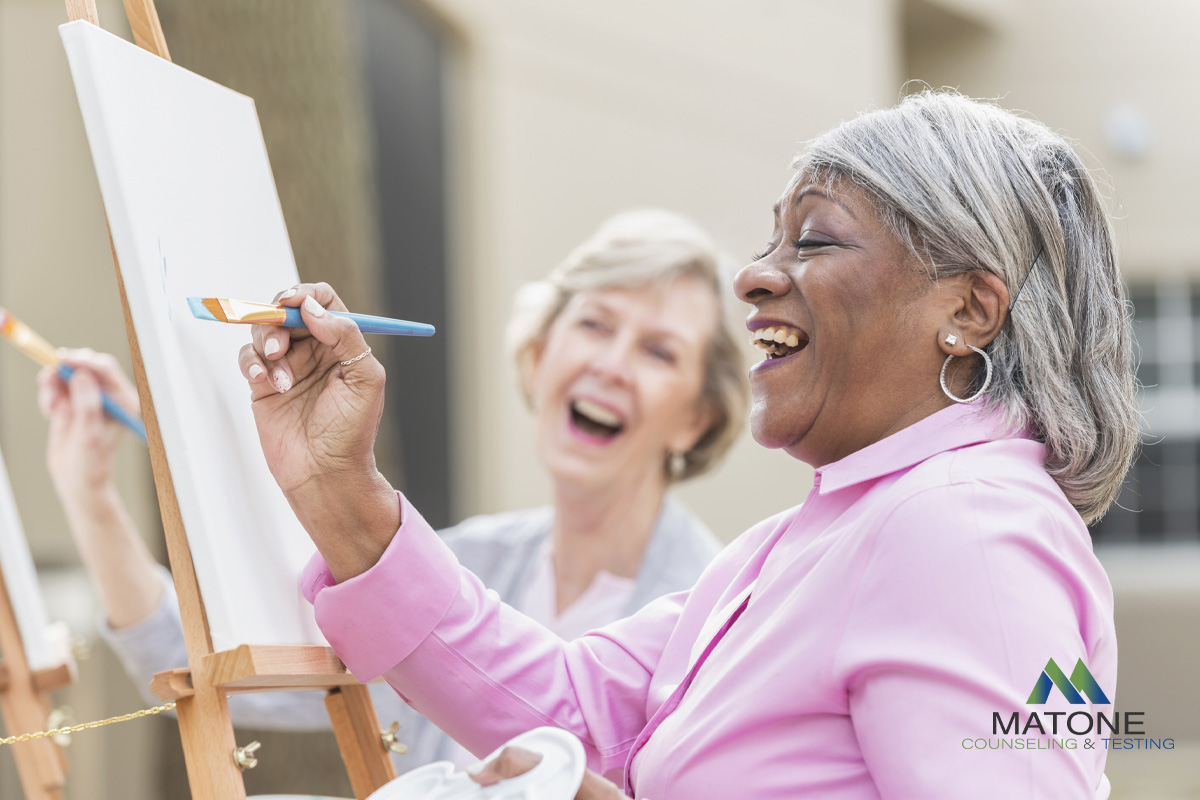What is Art Therapy?
Individuals around the world turn to art as a therapeutic process that is meant to heal. Art is often thought of as a true form of human expression. One in which our ideas are made tangible and observable. Through intentional work, individuals put a piece of themselves, or their identity, into their artwork. We can then begin to take a deeper look into the meanings and messages within the artwork we create. Art therapy can provide you with a creative alternative to traditional talk-therapy when it may first be easier to express yourself with images, narratives, or music, rather than words.
Art therapy began its development in the 1950s at the National Institute of Health. It saw a return to the National Institute of Health in the 1990s, considered recreational therapy (similar to play therapy). This service aims to target care through active art-making, the creative process, and applying psychological theory with your therapist. This can be done with a variety of different art mediums. You may choose to express yourself through drawing, painting, sculpture, writing, photography, music, theater, and even the contemplation of art pieces. This style of therapy can be used in one-on-one settings with your therapist or can be done with a group!
Art therapy is the focus of primarily using art to process emotions and bring a sense of greater fulfillment to an individual. Art therapists understand art supplies and the different processes for both therapy and art. They understand how to work with an array of different mediums, styles, and kinds of craft in order to effectively guide their clients through creating. Art therapy takes every part of the art process and applies therapeutic principles and psychoeducational learning. Art therapy then implores an unconditionally supportive environment that allows for authentic expression. This space then gives you a chance to challenge your perceptions of yourself and their worth.
Art therapy aims to:
- Improve cognitive and sensorimotor functioning
- Improve emotional and mental health
- Foster self-esteem and self-awareness
- Improve emotional resilience
- Promote insight
- Enhance social skills
- Reduce inner-conflict and promote change
This is done through gaining insight into your current functioning or mindfulness, learning self-compassion, and recognizing self-worth. During art therapy, you are encouraged to articulate complex thoughts and feelings through artistic mediums. Art therapy can be for those at any age or stage of life, but is especially effective for those with difficult experiences and an illness or disability. Specifically, art therapy has been seen to be effective in helping a wide variety of people who live with PTSD, trauma, anxiety and depression, substance abuse, and more. It is important to remember that you do not have to be an artist to benefit from and enjoy art therapy!
In art therapy, the art should be intentional. Without intention, there is no psychological anchor point for you to bring up inner conflict. In art therapy, there is a direct process that involves thinking about what you are going to create, the process of making the artwork, and then reflecting on what was created. When artwork is created with the intention of illustrating inner conflict, it can be looked at from a different perspective. This deeper perspective relates to the unique emotional experience that you convey through your artwork. You and your therapist work to reflect and restructure unhelpful thoughts and then apply these tools to other aspects of your life. These tools can also be used when approaching other and future inner conflicts with a sense of openness, nonjudgement, and curiosity.
Art therapy sessions are reflexive to the moment. Art therapy uses a client-centered approach that aims to address the current goals and intentions set collaboratively by the therapist and client. Initially, there is a focus on mindfulness and calming the body. This can be done through meditations, breathwork, and body scans. These methods can calm the mind and body, grounding you and allowing you to focus on the present moment.
The next step is the art making process. After grounding yourself, begin to observe and explore your thoughts and new ways to respond to their emotions. This is all done through artwork, and expressed intentionally with lines, shapes, color, hue, etc. This process is done without judgment, and is meant to be a true expression of your intentions.
Finally, you collaborate with your therapist to find a deeper understanding of the work that you created. This is done by talking with your therapist about the content of their work, the meaning behind it, and the process in which you experienced creating their work. All the while, your therapist is providing psychoeducation as they gain insight and begin to help you challenge unhelpful thoughts.
While research has seen improvements when using art therapy, many studies use various methods of art-making that may not work for everyone. Finding personal meaning and challenging negative thoughts can be a very intimate experience, and are often influenced by many factors in our lives. Take into consideration your preference for expressing yourself, and what ways would be most beneficial for you. It is important to remember that you do not have to be an artist to enjoy, and find insight from, art therapy! No matter your level of ability, art therapy opens a non-judgmental space that is centered around the process and emotions behind your artwork to analyze deeper conflicts.

Written by: William Blevins (He/Him/His), B.S. in Psychology
Will is a second-year master’s student in Clinical Psychology at Western Carolina University. He is interested in working with kids, teens, and young adults. He recognizes how early life is a critical time for development that can have lasting effects throughout life. He is interested in working with those struggling with anxiety, depression, effects of trauma, and other interpersonal difficulties. Will has a client centered approach to therapy and hopes to foster collaboration with his clients. He looks to give the client ultimate choice and to have the power over their change. Will understands that every individual has unique goals and experiences that shape what is best for them. He is also focused on creating an inclusive space for individuals, focused on affirmative practices. Will is interested in working with LGBTGIA+ folk to help them navigate their unique experience with the world and within their own community.
References




